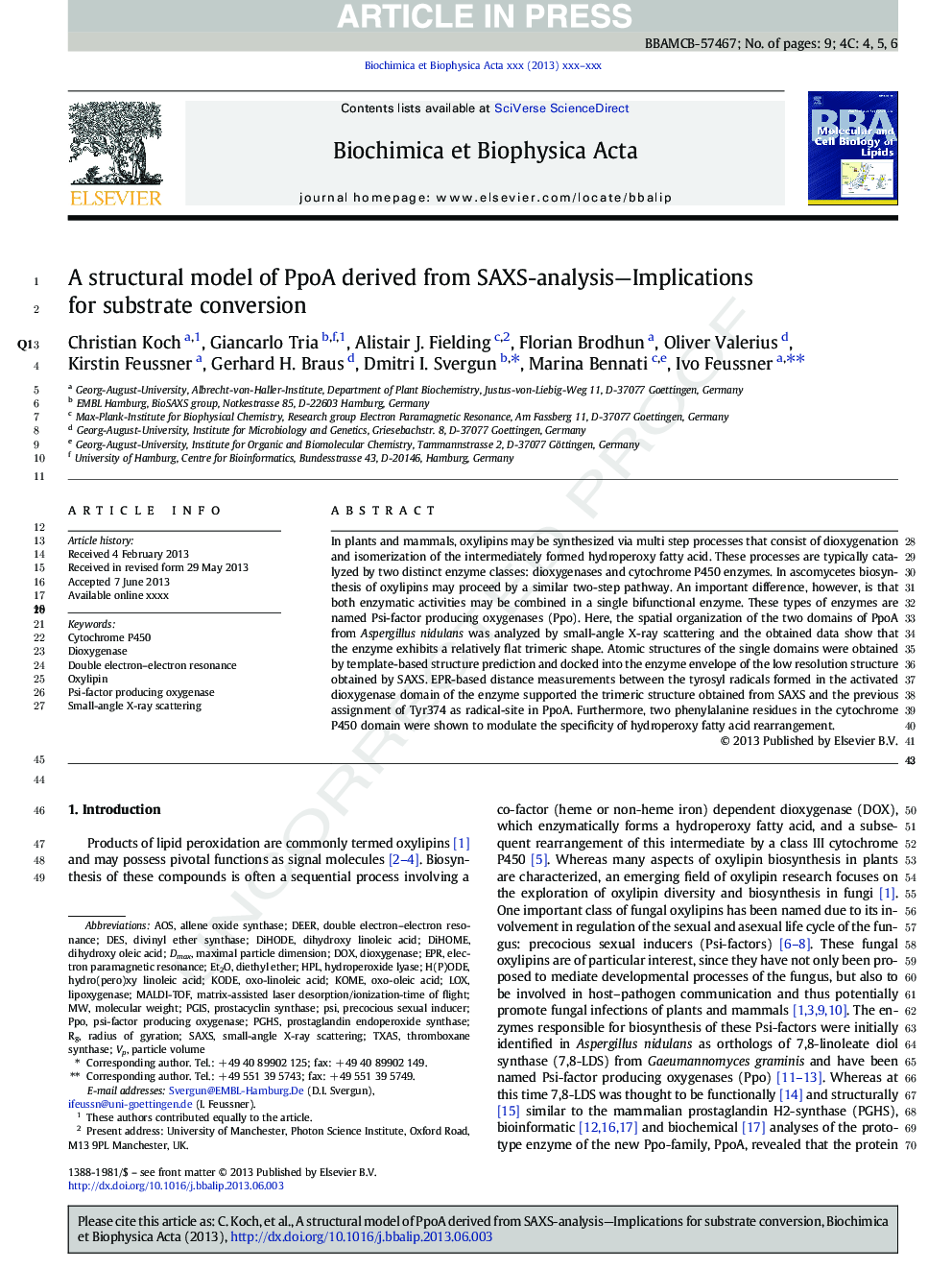| کد مقاله | کد نشریه | سال انتشار | مقاله انگلیسی | نسخه تمام متن |
|---|---|---|---|---|
| 8302545 | 1537738 | 2013 | 9 صفحه PDF | دانلود رایگان |
عنوان انگلیسی مقاله ISI
A structural model of PpoA derived from SAXS-analysis-Implications for substrate conversion
دانلود مقاله + سفارش ترجمه
دانلود مقاله ISI انگلیسی
رایگان برای ایرانیان
کلمات کلیدی
DOXKODEEt2OH(P)ODEKOMEPGISDmaxPPOPSIHPLMALDI-TOFDES - ازLOX - اکسیژن مایعAOS - بهElectron paramagnetic resonance - تشدید پارامغناطیس الکترونEPR - تشدید پارامغناطیس الکترونDiethyl ether - دی اتیل اترDioxygenase - دی اکسیژنازDivinyl ether synthase - دی دیینیل اتر سنتازDiHOME - دیهومDiHODE - دیویدDouble electron–electron resonance - رزونانس الکترون الکترون الکترونAllene oxide synthase - سنتاز اکسید آلنProstacyclin synthase - سنتاز پروستات سیکلینlipoxygenase - لیپواکسیژنازmatrix-assisted laser desorption/ionization-time of flight - مدت زمان جذب / زمان یونیزاسیون لیزر ماتریس کمک می کندHydroperoxide lyase - هیدروپراکسید لیازMolecular weight - وزن مولکولیDeer - گوزن
موضوعات مرتبط
علوم زیستی و بیوفناوری
بیوشیمی، ژنتیک و زیست شناسی مولکولی
زیست شیمی
پیش نمایش صفحه اول مقاله

چکیده انگلیسی
In plants and mammals, oxylipins may be synthesized via multi step processes that consist of dioxygenation and isomerization of the intermediately formed hydroperoxy fatty acid. These processes are typically catalyzed by two distinct enzyme classes: dioxygenases and cytochrome P450 enzymes. In ascomycetes biosynthesis of oxylipins may proceed by a similar two-step pathway. An important difference, however, is that both enzymatic activities may be combined in a single bifunctional enzyme. These types of enzymes are named Psi-factor producing oxygenases (Ppo). Here, the spatial organization of the two domains of PpoA from Aspergillus nidulans was analyzed by small-angle X-ray scattering and the obtained data show that the enzyme exhibits a relatively flat trimeric shape. Atomic structures of the single domains were obtained by template-based structure prediction and docked into the enzyme envelope of the low resolution structure obtained by SAXS. EPR-based distance measurements between the tyrosyl radicals formed in the activated dioxygenase domain of the enzyme supported the trimeric structure obtained from SAXS and the previous assignment of Tyr374 as radical-site in PpoA. Furthermore, two phenylalanine residues in the cytochrome P450 domain were shown to modulate the specificity of hydroperoxy fatty acid rearrangement.
ناشر
Database: Elsevier - ScienceDirect (ساینس دایرکت)
Journal: Biochimica et Biophysica Acta (BBA) - Molecular and Cell Biology of Lipids - Volume 1831, Issue 9, September 2013, Pages 1449-1457
Journal: Biochimica et Biophysica Acta (BBA) - Molecular and Cell Biology of Lipids - Volume 1831, Issue 9, September 2013, Pages 1449-1457
نویسندگان
Christian Koch, Giancarlo Tria, Alistair J. Fielding, Florian Brodhun, Oliver Valerius, Kirstin Feussner, Gerhard H. Braus, Dmitri I. Svergun, Marina Bennati, Ivo Feussner,